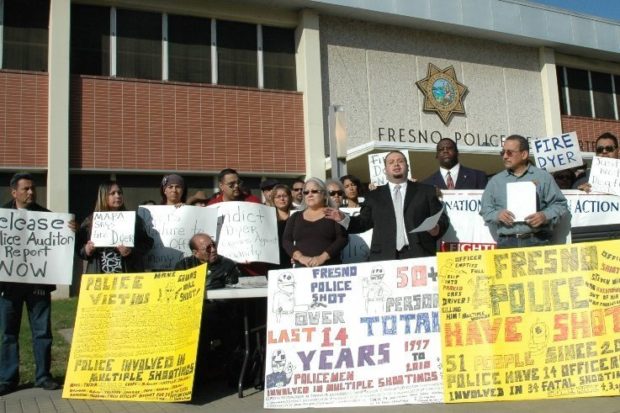
By Mike Rhodes
In early September 2011, the Community Alliance newspaper, through a California Public Records Act request, asked the Fresno Police Department (FPD) for its Policies and Procedures manuals. FPD Public Information Officer Donald Gross sent this response: “We will not be able to provide for this request due to officer safety issues and interference with ongoing investigations.”
The next day, Gross reversed this decision, writing that “the City will amend its previous response to your CPRA request and produce those portions of the Policy Manual that do not contain material that would endanger officers and/or compromise ongoing investigations and not reveal security and safety procedures. The City will need time to review the Policy Manual and will provide these records by October 4, 2011.”
Over the next year and three months, the FPD released its Policies and Procedures manuals, with significant sections of those documents redacted. Each release was accompanied by a letter detailing why those sections were removed. Those letters are included in our release of those manuals.
The documents we received were all on CDs and in a PDF format that was password protected so they could not be printed or copied (and pasted), making their usefulness greatly diminished. They also had a large watermark on each page identifying to whom they had been released, even though once they are released, there are no restrictions on their distribution. The FPD also charged us $30.50 for each of the six CDs, an excessive fee we believe given the current cost of transferring digital data.
The Policies and Procedures manuals we are providing (see link below) have been reformatted to make them more useful to anyone interested in learning more about police operations.
Although the FPD chose to withhold significant portions of its Policies and Procedures manuals, you can get an idea of what (basic) information those missing sections contain by looking at other police departments manuals, some of which are available online.
The Banning, Calif., police department, for example, provides its Policies and Procedures manual on its Website (www.banningpolice.org/policy.pdf).The transparency of the Banning Police Department stands in stark contrast to the FPD.
There is also a company that specializes in selling boilerplate Policies and Procedures manuals to police departments. You can find them at www.lexipol.com, which appears to be where much of the FPD manuals originally came from.
The Community Alliance’s purpose in requesting and now posting the Policies and Procedures manuals on our Website is to make the information available to the public. A person who has a copy of the Policies and Procedures manuals has a foundation to understand how the FPD operates. Now that we know what the policies and procedures are in the FPD, we can compare those with best practices at other police departments, and if changes need to be made we can make an effort to make those improvements.
I like to think of the release of these documents as one more tool in our toolbox as we work to ensure that the FPD does not do its work in a secretive and opaque manner. We are shining a light on local government with the goal of improving civil society and maintaining civilian control over law enforcement. After all, the people who work at the FPD are our employees. They work for us. We pay their salary. We have a right to know what they are doing.
The Policies and Procedures manuals are available via the following links. Each document is several megabytes in size, and each may take a few moments to download fully through even broadband Internet connections.
FPD Policy Manual:
https://fresnoalliance.com/wp-content/uploads/FPD-Policy-Manual.pdf
FPD Procedures Manual:
https://fresnoalliance.com/wp-content/uploads/FPD-Procedure-Manual.pdf
*****
Mike Rhodes is the editor of the Community Alliance newspaper. Contact him at editor@fresnoalliance.com.
